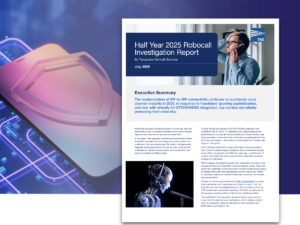When customers of a major US bank received text messages alerting them to unusual activity on their accounts, the text appeared to come from their bank and promised a follow-up call to help them protect their accounts. However, when the calls came through and details were handed over, it transpired that the bank had not called their customers, and instead they had become victims of a large-scale, multi-pronged phishing attack.
Bad actors had spoofed a bank telephone phone number, making it appear that the texts and calls were legitimate and duping customers into handing over personal details to those with nefarious motives.
In this blog, we provide a preview of our latest eBook ‘A Guide to Spoof Protection’. The eBook provides fraud and security professionals with the information they need to know to safeguard their company’s brand reputation and protect customers from spoofing attacks.
What is Caller ID Spoofing?
Caller ID spoofing is a tactic that bad actors are leveraging to defraud consumers around the world into believing they are talking to reputable enterprises, and your company could be at risk. A bad actor will falsely use a publicly facing telephone number to disguise their identity when making a call. For those who work to protect the security of enterprises, proactively preparing for outbound contact center fraud should be one of the items at the top of your list.
Reputation damage, penalties and the financial burden of reimbursing customers, in addition to a loss of trust in your company are just some of the serious impacts facing enterprises.
What is Outbound Contact Center Fraud?
Outbound contact center fraud is a term used to encapsulate the various actions taken, and tactics used, by a bad actor with the intent to deceive your customers into believing they are dealing directly with your enterprise. You may be familiar with robocalls, but caller ID spoofing is a form of outbound fraud that you may not be aware that your business has become the target of until it’s too late.
The technology used by bad actors is becoming more sophisticated meaning that even the most vigilant of enterprises can still fall victim.
How Can I Protect My Business from Call Spoofing?
By proactively deploying TNS Enterprise Authentication and Spoof Protection solutions, you can ensure that your business and customers are protected from falling victim to fraud.
TNS Enterprise Authentication: Leverages TNS’ Call Event API to ensure only legitimate and verified calls are delivered with branding to the end recipient. Unverified calls are marked as potential spam to warn customers.
TNS Spoof Protection: Ensures that any calls made by bad actors attempting to spoof your business numbers do not reach your customers and are blocked in the network.
Together, these award-winning solutions help to protect your enterprise brand and interactions with your customers, as well as improve answer rates and desired call outcomes.
A staggering 83% of consumers say that protecting customer data is extremely important to building their trust in a company1. Proactively protecting your customers’ data before it’s too late is one way to build this trust and protect the reputation of your brand at the same time.
TNS’ new eBook ‘A Guide to Spoof Protection’ provides you with everything you need to know about keeping your business safe from caller ID spoofing attacks, including a real-life case study of a large US bank who fell victim to a phishing attack and deployed TNS Enterprise Authentication and Spoof Protection solutions to rebuild trust in the voice channel.
Download ‘A Guide to Spoof Protection’ to learn more about protecting your brand and customers from caller ID spoofing today: https://tnsi.com/resource/com/guide-to-spoof-protection-ebook/
Maurie Munro is Vice President of Enterprise Sales at TNS with specific responsibility for its Communications Market solutions including Enterprise Authentication and Spoof Protection and Enterprise Branded Calling.
A Guide to Spoof Protection eBook
Complete the form for instant access to this eBook and find out how you can start to protect your brand and customers from falling victim to caller ID spoofing attacks.




